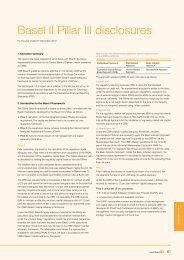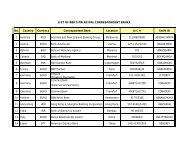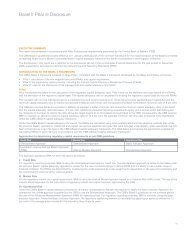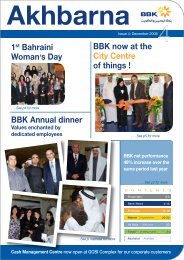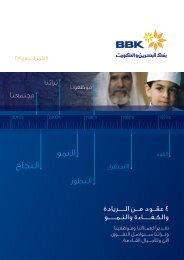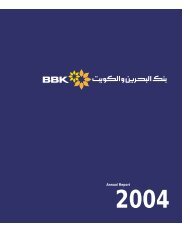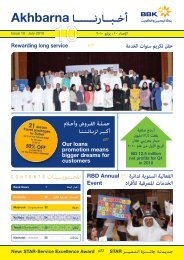BBK Annual Report 2011
BBK Annual Report 2011
BBK Annual Report 2011
You also want an ePaper? Increase the reach of your titles
YUMPU automatically turns print PDFs into web optimized ePapers that Google loves.
31 December <strong>2011</strong>Notes to the consolidated financial statements contineud<strong>BBK</strong> <strong>Annual</strong> <strong>Report</strong> <strong>2011</strong>503. Basis of preparation and significantaccounting policies continuedForeign currencies continuedNon-monetary items that are measured in terms of historical cost in aforeign currency are translated using the exchange rates as at the datesof the initial transactions. Non-monetary items measured at fair value in aforeign currency are translated using the exchange rates at the date whenthe fair value was determined. Any goodwill arising on the acquisition of aforeign operation and any fair value adjustments to the carrying amountsof assets and liabilities arising on the acquisition are treated as assets andliabilities of the foreign operations and translated at closing rate.(ii) Group companiesAs at the reporting date, the assets and liabilities of subsidiaries andoverseas branches are translated into the Group’s presentation currencyat the rate of exchange as at the statement of financial position date,and their statements of income are translated at the weighted averageexchange rates for the year. Exchange differences arising on translation aretaken directly to a separate component of equity through the consolidatedstatement of comprehensive income. On disposal of a foreign entity, thedeferred cumulative amount recognised in equity relating to that particularforeign operation is recognised in the consolidated statement of income.Cash and cash equivalentsCash and cash equivalents comprise cash and balances with centralbanks (excluding mandatory reserve deposits), treasury bills, deposits anddue from banks and other financial institutions with original maturities ofninety days or less.Trade date accounting and settlement date accountingAll “regular way” purchases and sales of financial assets are recognised onthe trade date, i.e. the date that the Group commits to purchase or sell theasset. Regular way purchases or sales are purchases or sales of financialassets that require delivery of assets within the time frame generallyestablished by regulation or convention in the market place.Significant accounting judgments and estimatesIn the process of applying the Group’s accounting policies, managementhas exercised judgment and estimates in determining the amountsrecognised in the consolidated financial statements. The most significantuses of judgment and estimates are as follows:Going concernThe Group’s management has made an assessment of the Group’s abilityto continue as a going concern and is satisfied that the Group has theresources to continue in business for the foreseeable future. Furthermore,the management is not aware of any material uncertainties that may castsignificant doubt upon the Group’s ability to continue as a going concern.Therefore, the consolidated financial statements continue to be preparedon the going concern basis.Fair value of financial instrumentsWhere the fair values of financial assets and financial liabilities recordedin the consolidated statement of financial position cannot be derivedfrom active markets, they are determined using a variety of valuationtechniques that include the use of mathematical models. The inputs tothese models are derived from observable market data where possible,but where observable market data is not available, judgment is required toestablish fair values. The judgments include considerations of liquidity andmodel inputs such as volatility for longer dated derivatives and discountrates, prepayment rates and default rate assumptions for asset backedsecurities.Classification of investmentsManagement decides on acquisition of an investment whether it should beclassified as held for trading, held to maturity, available-for-sale, fair valuethrough statement of income or investments carried at amortised cost.The Group classifies investments as trading if they are acquired primarilyfor the purpose of making a short term profit.The Group classifies debt instruments as carried at amortised cost if thedebt instruments are not quoted in an active market.The Group classifies investments which it intends and has the ability tohold to maturity as held-to-maturity.The Group classifies financial instruments which contain embeddedderivatives which cannot be separated from the host instrument as carriedat fair value through statement of income.All other investments are classified as available-for-sale.Impairment losses on loans and advances and investmentsThe Group reviews its individually significant loans and advances at eachstatement of financial position date to assess whether an impairmentloss should be recorded in the consolidated statement of income. Inparticular, judgment by management is required in the estimation of theamount and timing of future cash flows when determining the impairmentloss. In estimating these cash flows, the Group makes judgmentsabout the borrower’s financial situation and the net realisable value ofcollateral. These estimates are based on assumptions about a numberof factors and actual results may differ, resulting in future changes to theallowance.Loans and advances that have been assessed individually and found notto be impaired and all individually insignificant loans and advances are thenassessed collectively, in groups of assets with similar risk characteristics,to determine whether provision should be made due to incurred lossevents for which there is objective evidence but whose effects are not yetevident. The collective assessment takes account of data from the loanportfolio, concentrations of risks and economic data.Collective impairment provisions on loans and advancesIn addition to specific provisions against individually significant loans andadvances, the Group also makes a collective impairment provision againstgroups of loans and advances which have not been identified for allocatingspecific provision but carry higher risk of default than originally perceivedwhen the assets were booked.Impairment of non-trading investment securitiesThe Group reviews its debt securities classified as available-for-saleinvestments at each statement of financial position date to assesswhether they are impaired. This requires similar judgment as applied tothe individual assessment of loans and advances. The Group also recordsimpairment charges on available-for-sale equity investments when therehas been a significant or prolonged decline in the fair value below theircost. The determination of what is ‘significant’ or ‘prolonged’ requiresjudgment. In making this judgment, the Group evaluates, among otherfactors, historical share price movements and duration and the extent towhich the fair value of an investment is less than its cost.New standards and amendments issued but not yet effectiveStandards issued but not yet effective up to the date of issuance of theGroup’s consolidated financial statements are listed below. This listing is ofstandards and interpretations issued, which the Group reasonably expectsto be applicable at a future date. The Group intends to adopt thosestandards (where applicable) when they become effective:IAS 1 Financial statement presentationThe amendments becomes effective for annual periods beginning on orafter 1 July 2012 and require that an entity present separately, the itemsof other comprehensive income that would be reclassified (or recycled) toprofit or loss in the future if certain conditions are met (for example, uponderecognition or settlement), from those that would never be reclassified toprofit or loss. The amendment affects presentation only, therefore, will haveno impact on the Group’s financial position or performance.



